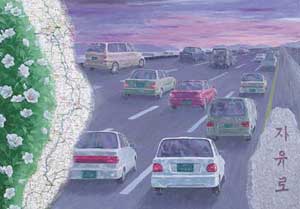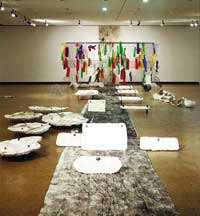Exhibition by ''Saebyeok'' entitled ''Road between North and South, National Highway No. 1 between Mokpo and Panmunjeom''


National Highway No. 1 that connects Mokpo in the southernmost region of the Korean peninsula and Shinuiju in North Korea used to be the main artery that ran across the Korean peninsula. Along this main artery lie traces of the modern history of Korea, which have been the theme of Jeollanamdo- and Gwangju-born artists such as Hwang Sun Chil, Yoo Sang Guk, Moon In Sang and Park Gwang Gu. These artists put their works together to create an exhibition that ran from August 14 to 20 at Gongpyeong Art Center in Insa-Dong. Headed by Hwang Sun Chil, the artists are members of the eleven-year-old group 'Saebyeok' (meaning 'dawn').
The exhibition, which sketches the modern history of Korea along the first highway to be built after the nation first opened port, is the brainchild of Saebyeok members who wanted to do a joint exhibition on the theme of national reunification. Their field survey began at Mokpo, where the highway begins. The artists started out by doing a gypsography of the original road sign at Mokpo. This was followed by a sketch of the Dongyang colonial company building that was constructed in the 1920s. This building, which had been the headquarters of the colonization of Korea, was used as the headquarters of the military police until 1989. Moving northward onto Gwangju, the artists revived the May 18 Gwangju Uprising through the Mangwoldong National Cemetery and the road in front of City Hall. They paid their respects to the heroes of the Donghak Farmers' Uprising in Jeongeup and went on to observe the wounds inflicted by the Korean War in Osan. The highlight of the field survey was at Panmunjeom, where the highway stopped off and the reality of a divided Korea glared the artists in the face.
Chair of Saebyeok Hwang said that the artists "focused on portraying the reality of the Korean peninsula where travelers have to cut short their northward journey at Panmunjeom." The Freedom Bridge over the Imjin River is where the exchange of prisoners of war took place after the armistice treaty put an end to the Korean War. Seven artists including Go Geun Ho and Kim Gi Beom made gypsum models of the piers and body of Freedom bridge to create a piece of installation art. The artists even made replicas of the barbed-wire entanglements on the bridge and duplicated the colored ribbons bearing the wishes of the visitors - young and old, even foreigners - tied to the barbed wire. Hwang said that he saw ribbons with wishes written in not only Japanese but also German and Arabic. He recalls heart-rending scenes of displaced persons tearfully writing the words "World Peace and Korean Reunification."
White cotton cloth stretches for more than 30 meters at the front and back of the barbed wire. The cloth, which had been spread out on the Freedom Bridge, bears Indian ink footprints of people who had visited the bridge. The nameless footprints conveyed the ardent desire to see the broken highway reconnected. A video recording of the field survey was continuously screened at the exhibition, a telling sign of the
artists' efforts to share their on-site experiences with the audience.
Seo Byeon Ok's work entitled <Daybreak> is a sketch of the day of freedom dawning on the juncture between the Northern Han River and Imjin River, and a frank expression of the artist's desire to continue his northward journey. Jung Cheol Hong's <Out of Nothing> is composed of two panels that seem to symbolize the Korean peninsula cut off in the middle and a red ball between the two panels meant to express the lump of unfulfilled yearnings and regrets shared by the Korean people.
It has been more than 50 years since the sign at Imjingak that reads <Location 126°22´52˝ of East Longitude and 34°47´01˝ North Latitude> imprinted a disconnected highway in the hearts of people in North and South Korea. At a time when the two Koreas are engaged in lively exchanges through the National Reunification Festival, the exhibition <Road between North and South> symbolizing communication and extension becomes all the more significant. One longs for the day when Highway No. 1, like the Kyongui Railway that was recently extended to Dorasan Station, will reach its destined terminal Shinuiju and the artists of 'Saebyeok' can finally continue their field survey northward.

